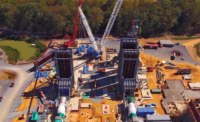Plans for construction of a 53-mile-long extension cord for San Francisco’s electric system are moving toward a start possibly as early as next month following approval of the project by the San Francisco Bay Conservation and Development Commission and award of a contract for engineering, procurement and construction. The $450-million submarine cable will link a substation in Pittsburg, Calif., to the Potrero Hill substation in San Francisco. Completion in March 2010 will allow the shuttering of a natural-gas-fueled generation plant that neighbors have long wanted closed.
In late September, Trans Bay Cable LLC, a wholly-owned subsidiary of Australia-based Babcock & Brown Ltd., awarded the EPC contract, valued at more than $150 million, to a consortium led by Siemens Power Transmission & Distribution Inc., Raleigh, N.C., with Prysmian SpA, Milan, Italy. Using Siemens’ HVDC PLUS system, the contractor will design, furnish and install converter stations at each end and lay a 200-kV direct-current cable with fiber-optic communication cable in a trench on the bay floor.
Ground will be broken for the converter station in Pittsburg by mid- to late January, but it could be done as early as November, says David Parquet, Trans Bay Cable vice president. Cable-lay must be scheduled for a narrow window because of environmental concerns. It will begin in summer 2009 and take 30 to 60 days to install, he says.
The California Independent System Operator chose the 200-kV direct-current Trans Bay Cable in September 2005 as the most feasible of several alternatives for transmission of power to San Francisco and northern San Mateo County. The city is a load pocket, sitting at the end of a peninsula with limited access to transmission lines and limited space for powerplants to be sited in its thickly-settled area. Still, local resistance was stiff.
“It seems like a pretty invasive approach to take just to get power to San Francisco,” says Sejal Choksi, program director of Baykeeper, an environmental group. Her biggest concern is that the bay’s floor is “heavily contaminated with mercury, PCBs and legacy pollutants, especially at locations such as Pittsburg and Potrero Hill.” Choksi supports the closing of outdated powerplants, but says, “putting the cable into the bay may prolong the life of other plants in the Pittsburg area.”
Pittsburg contains a concentration of natural-gas-fired powerplants, which environmental activists fear will supply most of the power to the new cable. But Parquet points out that nearby Solano County and Altamont Pass have extensive wind-energy resources that require a lot of transmission reinforcement. “We have provided a rifle shot of renewables right into San Francisco,” he says.
Atlanta-based Mirant Corp.’s 362-MW Potrero Hill Power Station will be shut down once the Trans Bay Cable is commissioned. Currently it is operating under a “reliability must-run” contract with the California ISO to ensure reliability of the local grid, says Gregg Fishman, ISO spokesman. “The Trans Bay Cable project will eliminate at least some of the need for local generation. The ISO has been working with PG&E, the City and County of San Francisco, local community groups and other stakeholders to find ways to reduce the reliance on the existing in-city generation, enabling us to remove the RMR status from the Potrero powerplant,” he says. “The City and County of San Francisco are in the process of also trying to site and install several small peaker plants, not necessarily in the city limits of San Francisco but electrically connected within the same constrained load pocket, which will help as well.”
The latest news and information
#1 Source for Construction News, Data, Rankings, Analysis, and Commentary
JOIN ENR UNLIMITEDCopyright ©2024. All Rights Reserved BNP Media.
Design, CMS, Hosting & Web Development :: ePublishing


Post a comment to this article
Report Abusive Comment